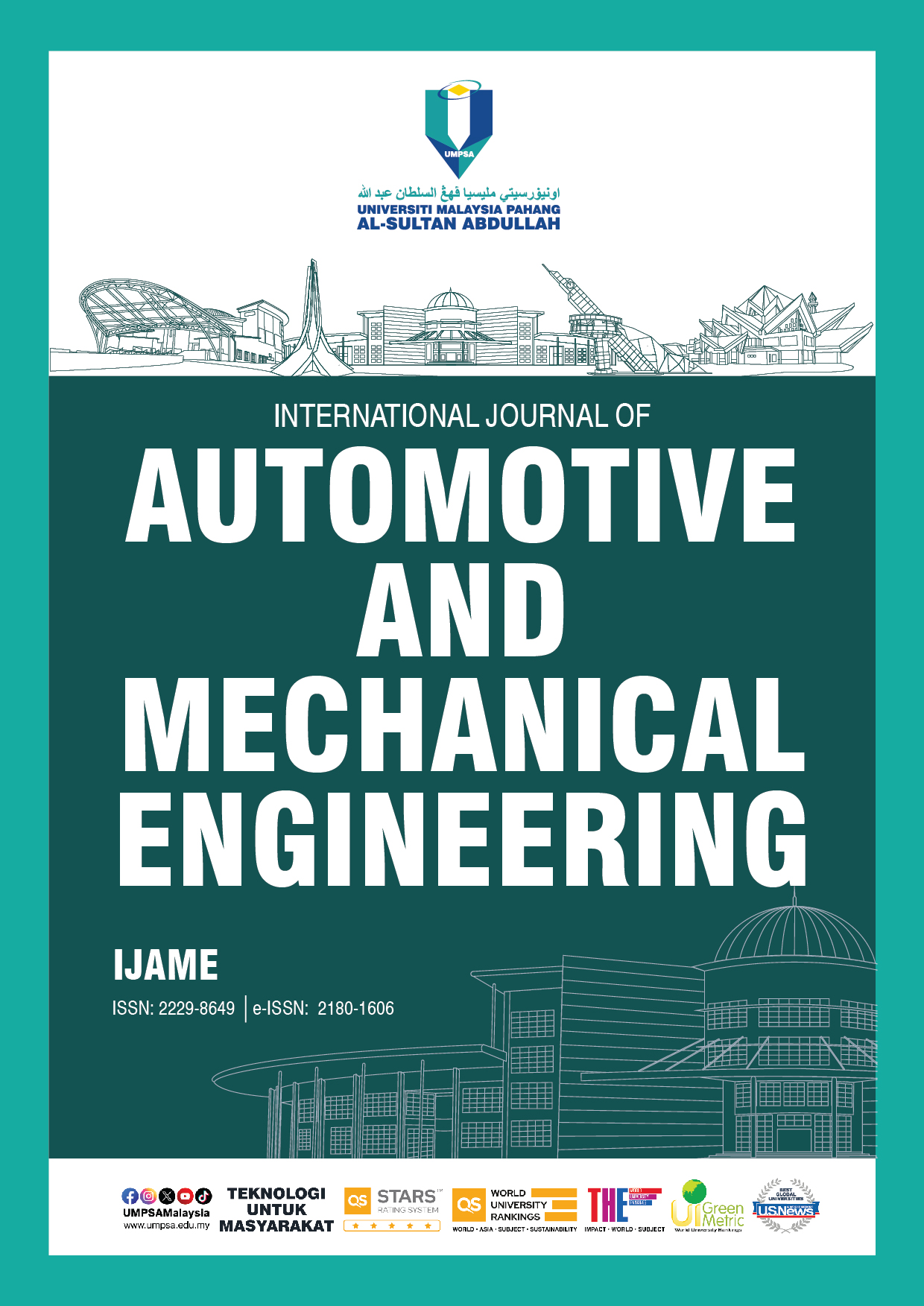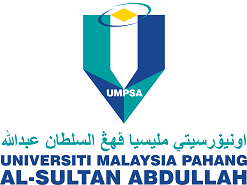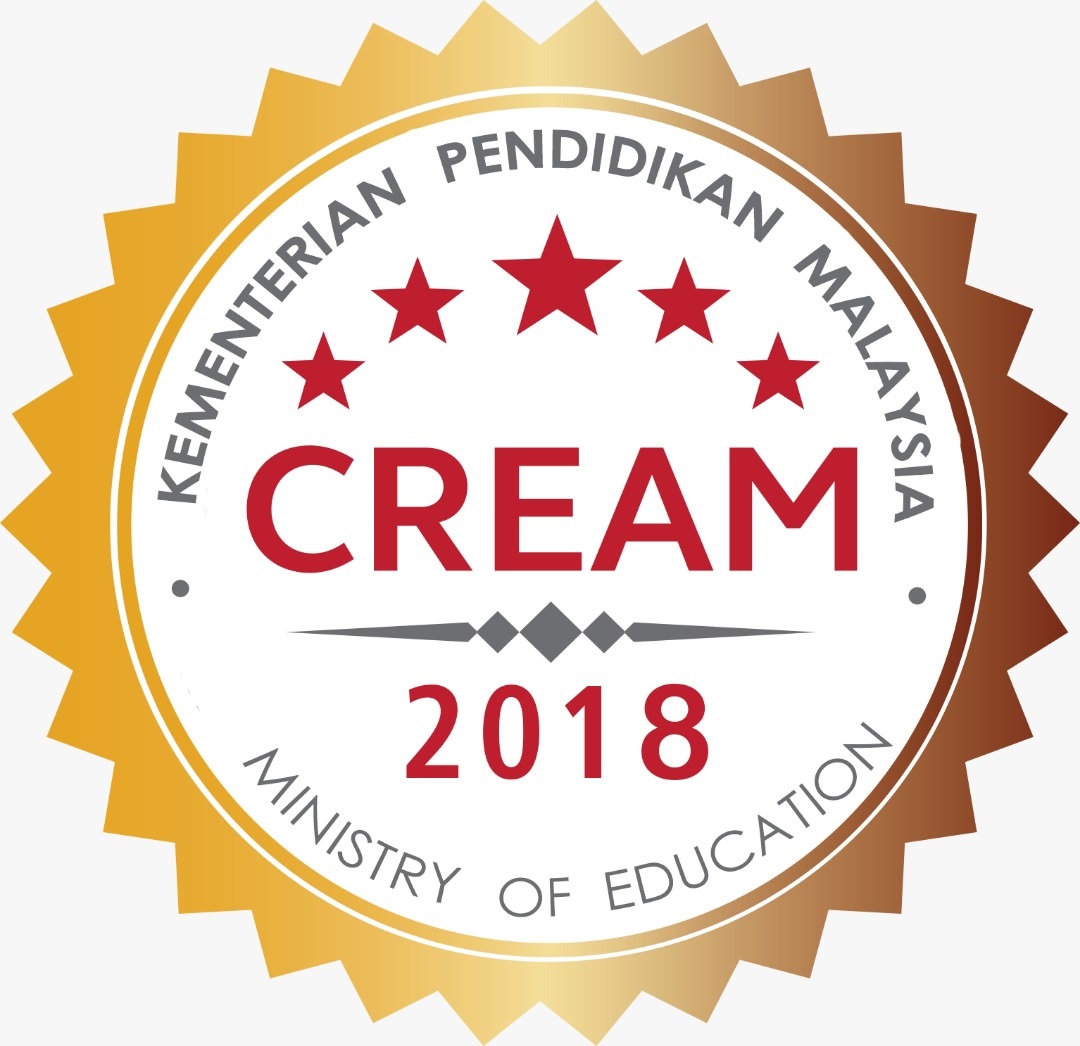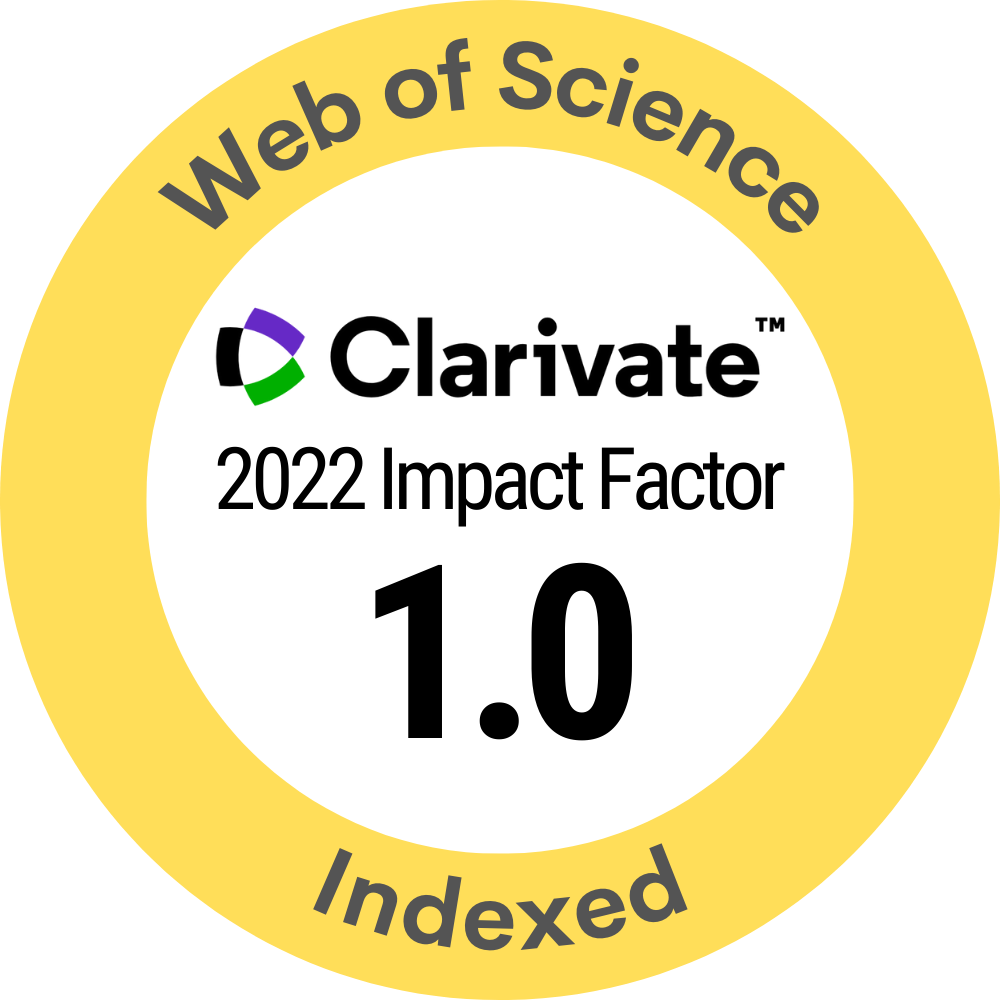Investigating Bio-Oil Yield from Co-pyrolysis of Mixed Medical Waste and Biomass under Varying Temperature and Residence Time
DOI:
https://doi.org/10.15282/ijame.22.2.2025.4.0941Keywords:
Co-pyrolysis, Medical waste, Residence-time, Temperature, Bio-oilAbstract
Co-pyrolysis is a thermochemical process using more than one raw material to become a new energy source without oxygen at high or low temperatures. This study aims to determine the effect of co-pyrolysis if temperature and residence time are varied on the yield of bio-oil mixed with biomass and medical waste. The research was conducted using a small-scale batch reactor equipped with an electrically controlled band heater as a reactor tube heater. Co-pyrolysis was carried out with variations in temperature, namely 300°C, 400°C, and 500°C, as well as three different raw material waiting times in the reactor, namely 10, 15, and 20 minutes. The flow rate of nitrogen gas to the reactor is set at 0.5 liters per minute, and the number of samples taken for each batch procedure is 60 grams. The results showed that increasing the temperature positively affected bio-oil yield, but applying very high temperatures had the opposite effect, namely decreasing the amount of bio-oil but increasing the amount of syn-gas produced. Residence time dramatically affects the composition of the bio-oil and syn-gas compounds produced but does not significantly affect the biochar yield. At lower and moderate temperatures, prolonging the residence time enhances bio-oil production. However, at 500°C, extending the residence time diminishes bio-oil yield. The bio-oil obtained has a high calorific value of 46.334 MJ/kg, making it suitable for use as an alternative fuel.
References
[1] R. J. Watts and A. L. Teel, “Groundwater and air contamination: Risk, toxicity, exposure assessment, policy, and regulation,” in Treatise on Geochemistry: Second Edition, vol. 11, pp. 1–12, 2013.
[2] A. Hazra, S. Das, P. K. Chatterjee, A. Ganguly, and P. Banerjee, “Gasification of hospital waste by thermal plasma: A relevant technology towards mitigation of greenhouse gases in India,” in Encyclopedia of Renewable and Sustainable Materials, vol. 1–5, pp. 454–462, 2020.
[3] G. Su, H. C. Ong, M. Mofijur, T. M. I. Mahlia, and Y. S. Ok, “Pyrolysis of waste oils for the production of biofuels: A critical review,” Journal of Hazardous Materials, vol. 424, p. 127396, 2022.
[4] A. Sivakumar, R. Sathiyamoorthi, V. Jayaseelan, R. Ashok Gandhi, and K. Sudhakar, “Performance of Waste Insulating Mineral Oil-Based Biodiesel in a Direct-Injection CI Engine,” International Journal of Automotive and Mechanical Engineering, vol. 18, no. 4, pp. 9349–9361, 2021.
[5] S. Dharmaraj, S. Dharmaraj, V. Ashokkumar, R. Pandiyan, H. S. H. Munawaroh, K. W. Chew, W. H. Chen, et al., “Pyrolysis: An effective technique for degradation of COVID-19 medical wastes,” Chemosphere, vol. 275, p. 130092, 2021.
[6] S. Fang, L. Jiang, P. Li, J. Bai, and C. Chang, “Study on pyrolysis products characteristics of medical waste and fractional condensation of the pyrolysis oil,” Energy, vol. 195, p. 116969, 2020.
[7] M. E. H. M. Ahmed, S. A. T. Muawad, A. K. A. Ahmed, and A. A. A. Abuelnuor, “Waste to energy: Recovery of alternative energy source from thermal pyrolysis of medical waste in Khartoum, Sudan,” in 2020 International Conference on Computer, Control, Electrical, and Electronics Engineering (ICCCEEE), 2021, pp. 1–5.
[8] F. A. Devitra, A. Syuriadi, and I. Nuriskasari, “Analisis nilai kalor pada bio-oil jenis biomassa limbah kotoran hewan dan limbah pressan biji nyamplung hasil pirolisis,” in Prosiding Seminar Nasional Teknik Mesin, no. 1, pp. 1283–1289, 2022.
[9] G. Giakoumakis, D. Politi, and D. Sidiras, “Medical waste treatment technologies for energy, fuels, and materials production: A review,” Energies (Basel), vol. 14, no. 23, p. 8065, 2021.
[10] M. F. Dimin, S. M. Se, A. Shaaban and M. M. Hashim, “Urea impregnated biochar to minimize nutrients loss in paddy soils,” International Journal of Automotive and Mechanical Engineering, vol. 10, no. 3, pp. 2016-2024, 2014.
[11] M. J. Ahmed and B. H. Hameed, “Insight into the co-pyrolysis of different blended feedstocks to biochar for the adsorption of organic and inorganic pollutants: A review,” Journal of Cleaner Production, vol. 265, p. 121762, 2020.
[12] Z. Luo, X. Zhu, J. Deng, K. Gong, and X. Zhu, “High-value utilization of mask and heavy fraction of bio-oil: From hazardous waste to biochar, bio-oil, and graphene films,” Journal of Hazardous Materials, vol. 420, p. 126570, 2021.
[13] C. Park, H. Choi, K. Y. Andrew Lin, E. E. Kwon, and J. Lee, “COVID-19 mask waste to energy via thermochemical pathway: Effect of Co-Feeding food waste,” Energy, vol. 230, p. 120876, 2021.
[14] H. Wang, S. Deng, J. Yang, X. Liu, G. Si, H. Jin, et al., “Analysis and techno-economic evaluation of co-pyrolysis of medical protective clothing and biomass,” Journal of Environmental Management, vol. 377, p. 124567, 2025.
[15] J. Yang, J. Rizkiana, W. B. Widayatno, S. Karnjanakom, M. Kaewpanha, X. Hao, et al., “Fast co-pyrolysis of low density polyethylene and biomass residue for oil production,” Energy Conversion and Management, vol. 120, pp. 422–429, 2016.
[16] F. Abnisa and W. M. A. Wan Daud, “Optimization of fuel recovery through the stepwise co-pyrolysis of palm shell and scrap tire,” Energy Conversion and Management, vol. 99, pp. 334–345, 2015.
[17] S. Krerkkaiwan, C. Fushimi, A. Tsutsumi, and P. Kuchonthara, “Synergetic effect during co-pyrolysis/gasification of biomass and sub-bituminous coal,” Fuel Processing Technology, vol. 115, pp. 11–18, 2013.
[18] W. Mateo, H. Lei, E. Villota, M. Qian, Y. Zhao, E. Huo, et al., “Synthesis and characterization of sulfonated activated carbon as a catalyst for bio-jet fuel production from biomass and waste plastics,” Bioresource Technology, vol. 297, p. 122411, 2020.
[19] B. B. Uzoejinwa, X. He, S. Wang, A. El-Fatah Abomohra, Y. Hu, and Q. Wang, “Co-pyrolysis of biomass and waste plastics as a thermochemical conversion technology for high-grade biofuel production: Recent progress and future directions elsewhere worldwide,” Energy Conversion and Management, vol. 163, no. February, pp. 468–492, 2018.
[20] Y. Ayub and J. Ren, “Revealing the synergistic effect of feedstock compositions and process parameters in co-pyrolysis: A review based on bibliometric analysis and experimental studies,” Journal of Cleaner Production, vol. 459, p. 142540.
[21] I. L. Motta, A. N. Marchesan, H. R. Guimaraes, M. F. Chagas, A. Bonomi, M. R. W. Maciel, et al., “Co-pyrolysis of lignocellulosic residues and plastics: A simulation approach to predict product yields,” Chemical Engineering Transactions, vol. 109, pp. 139–144, 2024.
[22] W. Meka, A. Ridwan, Y. Fitri, Y. Dewilda, R. A. Mahendra, T. N. Rezeki, et al., “Experimental analysis of the recovery and chemical properties of pyrolytic oil derived from medical waste with varying components combined via a systematic combination approach,” International Journal of Green Energy, vol. 21, no. 3, pp. 500–511, 2024.
[23] S. T. Kumaravel, A. Murugesan, and A. Kumaravel, “Tyre pyrolysis oil as an alternative fuel for diesel engines – A review,” Renewable and Sustainable Energy Reviews, vol. 60, pp. 1678–1685, 2016.
[24] D. Singh and A. Paul, “Characterization and performance evaluation of co-pyrolysis oil from waste cooking oil and waste polyethylene as a potential diesel substitute,” Fuel, vol. 362, p. 130739, 2024.
[25] A. P. Athala, Y. Fitri, W. Meka, A. Ridwan, R. A. Mahendra, T. N. Rezeki, et al., “Analisa eksperimental terhadap distribusi produk co-pyrolysis limbah sarung tangan medis dan limbah biomassa,” Jurnal Teknik Kimia, vol. 28, no. 3, p. 116-125, 2022.
[26] A. P. Athala, A. Ridwan, and M. Hamzah, “Analisa eksperimental terhadap distribusi produk co-pyrolysis limbah sarung tangan medis dan limbah biomassa Experimental analysis on distribution of co-pyrolysis products from medical glove waste and biomass waste,” Jurnal Teknik Kimia, vol. 28, no. 3, pp. 116-125, 2022.
[27] Y. Theopilus, T. Yogasara, C. Theresia, and J. R. Octavia, “Analisis risiko produk Alat Pelindung Diri (APD) pencegah penularan COVID-19 untuk pekerja informal di Indonesia,” Jurnal Rekayasa Sistem Industri, vol. 9, no. 2, pp. 115–134, 2020.
[28] R. Chen, D. Zhang, X. Xu, and Y. Yuan, “Pyrolysis characteristics, kinetics, thermodynamics and volatile products of waste medical surgical mask rope by thermogravimetry and online thermogravimetry-Fourier transform infrared-mass spectrometry analysis,” Fuel, vol. 295, p. 120632, 2021.
[29] T. N. Rezeki, A. Ridwan, W. Meka, Y. Fitri, R. A. Mahendra, M. Hamzah, et al., “Analysis of pyrolytic product distribution for B3 and non-B3 medical waste pyrolysis,” CHEESA: Chemical Engineering Research Articles, vol. 5, no. 2, p. 101, 2022.
[30] A. Ephraim, D. Pham Minh, D. Lebonnois, C. Peregrina, P. Sharrock, and A. Nzihou, “Co-pyrolysis of wood and plastics: Influence of plastic type and content on product yield, gas composition and quality,” Fuel, vol. 231, pp. 110–117, 2018.
[31] Z. Ding, H. Chen, J. Liu, H. Cai, F. Evrendilek, and M. Buyukada, “Pyrolysis dynamics of two medical plastic wastes: Drivers, behaviors, evolved gases, reaction mechanisms, and pathways,” Journal of Hazardous Materials, vol. 402, p. 123472, 2021.
[32] M. Saritha, A. Arora, and Lata, “Biological pretreatment of lignocellulosic substrates for enhanced delignification and enzymatic digestibility,” Indian Journal of Microbiology, vol. 52, pp.122-130, 2012.
[33] S. A. Babajo, “Production of liquid fuel from co-pyrolysis of jatropha cake with tyre waste,” Environmental Research and Technology, vol. 5, no. 2, pp. 111-118, 2022.
[34] E. E. Kwon, S. Kim, and J. Lee, “Pyrolysis of waste feedstocks in CO2 for effective energy recovery and waste treatment,” Journal of CO2 Utilization, vol. 31, pp.173-180, 2019.
[35] S. D. Anuar Sharuddin, F. Abnisa, W. M. A. Wan Daud, and M. K. Aroua, “A review on pyrolysis of plastic wastes,” Energy Conversion and Management, vol. 115, pp. 308–326, 2016.
[36] A. Veses, J. M. López, T. García, and M. S. Callén, “Prediction of elemental composition, water content and heating value of upgraded biofuel from the catalytic cracking of pyrolysis bio-oil vapors by infrared spectroscopy and partial least square regression models,” Journal of Analytical and Applied Pyrolysis, vol. 132, pp. 102–110, 2018.
[37] A. Inayat, A. Ahmed, R. Tariq, A. Waris, F. Jamil, S. F. Ahmed, et al., “Techno-economical evaluation of bio-oil production via biomass fast pyrolysis process: A review,” Frontiers in Energy Research, vol. 9, p. 770355, 2022.
[38] A. Zulkania, “Pengaruh temperatur dan ukuran partikel biomassa terhadap bio-oil hasil pirolisis ampas tebu/baggase,” Teknoin, vol. 22, no. 5, pp. 328–336, 2016.
[39] K. Udyani, E. Ningsih, and M. Arif, “Pengaruh temperatur pirolisis terhadap yield dan nilai kalor bahan bakar cair dari bahan limbah kantong plastik,” Prosiding Seminar Nasional Sains dan Teknologi Terapan VI, no. 2013, pp. 389–394, 2018.
[40] M. S. Cahyono, “Influence of residence time to the properties of liquid product from plastic waste pyrolysis,” Multitek Indonesia, vol. 14, no. 1, p. 34, 2020.
[41] H. H. Shah, M. Amin, A. Iqbal, I. Nadeem, M. Kalin, A. M. Soomar, et al., “A review on gasification and pyrolysis of waste plastics,” Frontiers in Chemistry, vol. 10, p. 960894, 2023.
[42] F. J. Mastral, E. Esperanza, C. Berrueco, M. Juste, and J. Ceamanos, “Fluidized bed thermal degradation products of HDPE in an inert atmosphere and in air-nitrogen mixtures,” Journal of Analytical and Applied Pyrolysis, vol. 70, no. 1, pp. 1–17, 2003.
[43] S. V. Papuga, P. M. Gvero, and L. M. Vukić, “Temperature and time influence on the waste plastics pyrolysis in the fixed bed reactor,” Thermal Science, vol. 20, no. 2, pp. 731–741, 2016.
[44] Z. Tan, Y. Li, F. Chen, J. Liu, J. Zhong, L. Guo, et al., “Challenges and perspectives of the conversion of lignin waste to high-value chemicals by pyrolysis,” Processes, vol. 12, no. 3, p. 589, 2023.
[45] G. R. Mong, C. T. Chong, W. W. F. Chong, J. H. Ng, H. C. Ong, V. Ashokkumar, et al., “Progress and challenges in sustainable pyrolysis technology: Reactors, feedstocks and products,” Fuel, vol. 324, p. 124777, 2022.
[46] P. Das, “The effect of slow pyrolysis on the conversion of packaging waste plastics (PE and PP) into fuel,” Waste Management, vol. 79, pp. 615–624, 2018.
[47] M. Karagöz, Ü. Ağbulut, and S. Sarıdemir, “Waste to energy: Production of waste tire pyrolysis oil and comprehensive analysis of its usability in diesel engines,” Fuel, vol. 275, p. 117844, 2020.
[48] Q. Wu, Q. Zhang, X. Chen, G. Song, and J. Xiao, “Life cycle assessment of waste tire recycling: Upgraded pyrolytic products for new tire production,” Sustainable Production and Consumption, vol. 46, pp. 294–309, 2024.
[49] Z. Wang, K. G. Burra, M. Zhang, X. Li, M. Policella, T. Lei, et al., “Co-pyrolysis of waste tire and pine bark for syngas and char production,” Fuel, vol. 274, p. 117878, 2020.
[50] R. García, C. Pizarro, A. G. Lavín, and J. L. Bueno, “Characterization of Spanish biomass wastes for energy use,” Bioresource Technology, vol. 103, no. 1, pp. 249–258, 2012.
[51] Z. Wang, K. G. Burra, M. Zhang, X. Li, M. Policella, T. Lei, et al., “Co-pyrolysis of waste tire and pine bark for syngas and char production,” Fuel, vol. 274, 2020.
[52] Q. Lu, W. Z. Li, and X. F. Zhu, “Overview of fuel properties of biomass fast pyrolysis oils,” Energy Conversion and Management, vol. 50, no. 5, pp. 1376–1383, 2009.
Downloads
Published
Issue
Section
License
Copyright (c) 2025 The Author(s)

This work is licensed under a Creative Commons Attribution-NonCommercial 4.0 International License.







